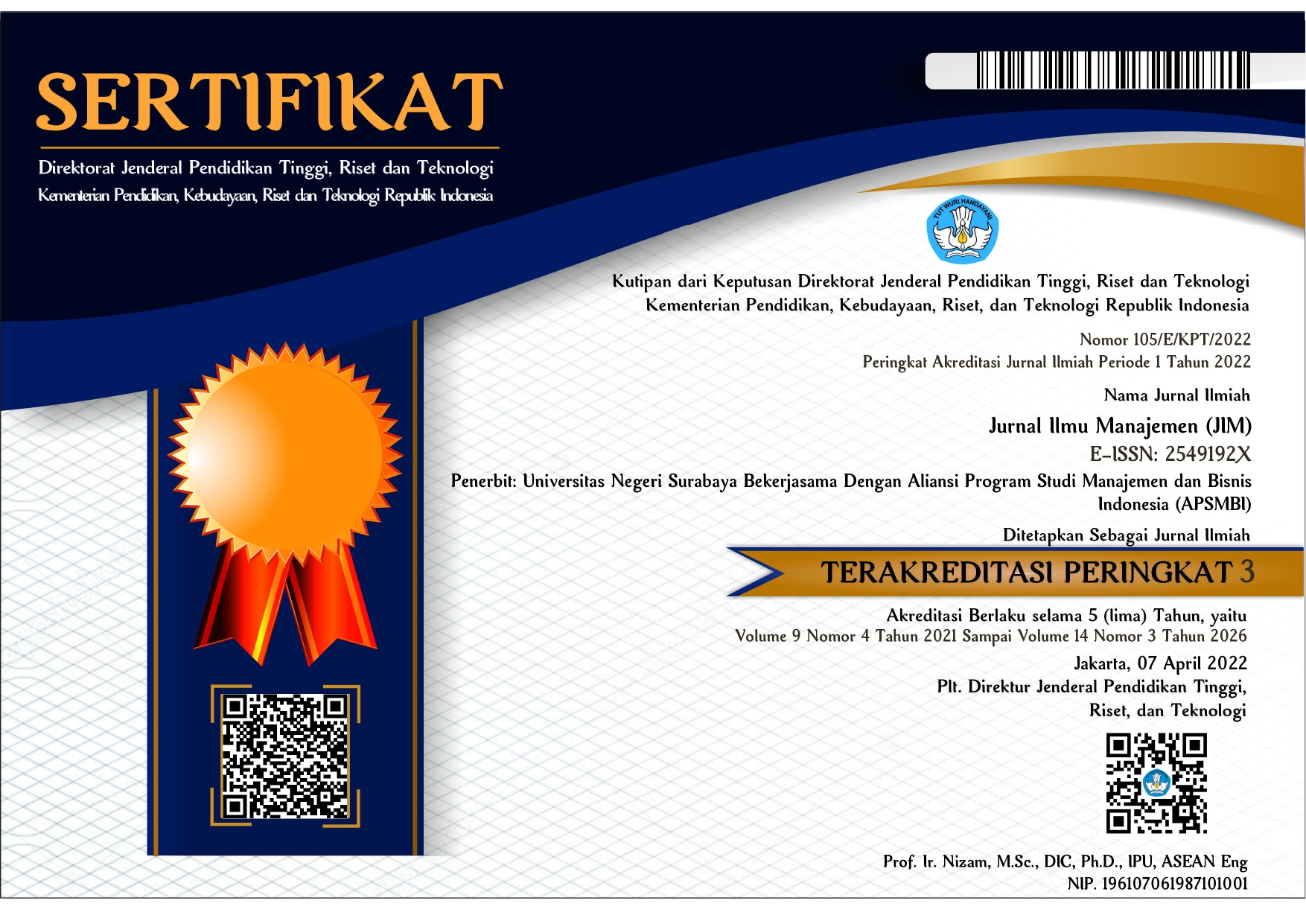Pengaruh iklan dan promosi penjualan terhadap keputusan menginap di budget hotel
DOI:
https://doi.org/10.26740/jim.v13n2.p530-539Keywords:
advertising, budget hotel, consumer behavior, sales promotion, stay decisionAbstract
This study aims to explore the influence of advertising and sales promotion on consumers’ decisions to stay at budget hotels in Surabaya. Specifically, it seeks to assess whether these two marketing variables significantly affect consumer behavior, both independently and jointly, in the hospitality industry. The research also intends to offer empirical evidence regarding the effectiveness of promotional activities implemented by budget hotels. By doing so, it strives to deliver strategic insights for developing more personalized and impactful marketing communications. With the increasing use of digital platforms and social media, understanding how these channels shape consumer perceptions and decisions becomes essential particularly in a competitive and price-sensitive market. From an academic perspective, the findings are expected to enrich the literature on service marketing by examining consumer responses to advertising and promotions within the context of affordable lodging options. Practically, the study serves as a tool for hotel managers to understand their target audience better and to design data-informed promotional strategies that align with the evolving needs and expectations of value-conscious travelers. This dual emphasis on theoretical contribution and practical application, the study to offer meaningful input for both marketing scholarship and managerial practice in Indonesia’s tourism landscape.
References
Aas, T. H., & Pedersen, P. E. (2011). The impact of service innovation on firm-levelfinancial performance. The Service Industries Journal, 31(13), 2071–2090.
Alam I and Perry C (2002). A customer-oriented new service development process. Journal of Services Marketing 16(6): 515–534.
Anastasia, Melliana. 2006. Menjelajah Tubuh: Perempuan dan Mitos Kecantikan. Yogyakarta: Lkis
Antoncic, B. and Hisrich, R.D. (2001), “Intrapreneurship: construct refinement and cross-cultural validation”, Journal of Business Venturing, Vol. 16, pp. 495-527.
Amrullah, Siburian, P. S., & ZA, S. Z. (2016). Pengaruh Kualitas Produk dan Kualitas Layanan Terhadap Keputusan Pembelian Sepeda Motor Honda. Kinerja : Jurnal Ekonomi Dan Manajemen, 13(2), 99–118.
Arslan, M., & Zaman, R. (2014). Impact of Brand Image and Service Quality on Consumer Purchase Intention: A Study of Retail Store in Pakistan. 4(22), 2225–2484.
Assauri, Sofjan. 2013. Manajemen Pemasaran. Jakarta : Rajawali Pers.
Atik,dan ratminto. 2005. Manajemen Pelayanan, disertai dengan pengembangan model konseptual, penerapan citizen’s charter dan standar pelayanan minimal. Yogyakarta: Pustaka Pelajar.
Bharwani S and Mathews D (2016) Customer service innovations in the Indian hospitality industry. Worldwide Hospitality and Tourism Themes 8(4): 416–431.
Bian, Qin and Forsythe, Sandra. 2011. Purchase intention for luxury brands: A cross cultural comparison. Journal of Business Research.
De Jong, J.P.J., Bruins, A., Dolfsma, W., & Meijgaard, J. (2003). Innovation in service firms explored: What, how and why? Strategic study B200205. Zoetermeer: EIM Business & Policy Research.
Den Hertog, P. (2000). Knowledge-intensive business services as co-producers ofinnovation. International Journal of Innovation Management, 4(4), 491–528.
Djaya, A.M. (2007). Natural Beauty Inner Beauty: Manajemen Diri Meraih Kecantikan Sejati dari Khazanah Tradisional. Yogyakarta: Kreasi Wacana.
Engel. (2000). Perilaku Konsumen. Edisi Keenam. Jidil I. Jakarta: Binarupa Aksara.
Grönroos, C. (2007). Service management and marketing (3rd ed.). Chichester: JohnWiley.
Hapsari, A. P. (2008). Analisis Perbandingan Penggunaan Celebrity Endorser dan Typical-Person Endorser dan Hubungannya Dengan Brand Image Produk. Jurnal Bisnis dan Manajemen.
Hartono, H., Hutomo, K., & Mayangsari, M. (2012). Pengaruh Strategi Pemasaran Terhadap Peningkatan Penjualan Pada Perusahaan” Dengan Menetapkan Alumni Dan Mahasiswa Universitas Bina Nusantara Sebagai Objek Penelitian. Binus Business Review, 3(2), 882-897.
Howard, J. A. (1994). Buyer Behavior in Marketing Strategy, 2nd Edition. New Jersey: Prentice-Hall.
Kartajaya, H. (2009). New Wave Marketing. Jakarta: Gramedia Pustaka.
Keller, K. L. (1993). How to manage brand equity. Jakarta: Gramedia Pustaka.
Keller, K. L. (1998). Strategic Brand Management: Building, Measuring, and Managing Brand Equity. New Jersey: Prentice Hall.
Kotler, P dan G. Amstrong. 2008. Prinsip-Prinsip Pemasaran. Jilid 1, Edisi 12. Jakarta: Erlangga.
Kotler, P. (2009). Manajemen Pemasaran. Jakarta: Erlangga.
Kotler, P., & Keller, K. (2009). Manajemen Pemasaran, Edisi 13, Jilid 1 dan 2. Jakarta: Erlangga.
Kotler, Philip and Kevin Lane Keller, 2011. Manajemen Pemasaran, Edisi 13 Jilid 1 dan 2, Alih Bahasa : Bob Sabran, Erlangga, Jakarta.
Kotler, Philip. (2002). Manajemen pemasaran. Jilid kedua. (10th ed). Jakarta: Prenhallindo.
Kotler, Philip. 2005. Manajemen Pemasaran Jilid 1. Benyamin Molan, Penerjemah, Jakarta : PT Indeks.
Lemy, Diena., Edmund Goh & Jie Ferry. (2019). Moving out of the silo: How service quality innovations can develop customer loyalty in Indonesia’s hotels. Journal of Vacation Marketing, 1-18.
Lin, N. (2007). The Effect of Brand Image and Product Knowledge on Purchase Intention Moderated by Price Discount. August, 121–132.
Malhotra, N.K. (2017). Riset Pemasaran.
New York: McGraw-Hill.
Narver, J.C., & Slater, F.S. (1990). The effect of a market orientation on business profitability. Journal of Marketing, 54(4), 20–35.
Rangkuti, F. (2008). The Power of Brands. Jakarta: Gramedia.
Reinartz, W., & Ulaga, W. (2008). How to sell services more profitably. HarvardBusiness Review, 86(5), 90.
Resmawa, I. N. (2017). Pengaruh Brand Image dan Product Knowledge terhadap Purchase Intention dengan Green Price sebagai Moderating Variabel pada Produk the Body Shop di Surabaya. Jurnal Aplikasi Manajemen, Ekonomi Dan Bisnis, 1(2), 1–11.
Supranto, J. 2006. Pengukuran Tingkat Kepuasan Pelanggan Untuk Menaikkan Pangsa Pasar. Jakarta.
Tajeddini, K., Trueman, M. and Larsen, G. (2006), “Examining the effect of market orientation on innovativeness”, Journal of Marketing Management, Vol. 22 Nos 5/6, pp. 529-51.
Tambajong, Geraldy. 2013. Bauran Pemasaran Pengaruhnya Terhadap Penjualan Sepeda Motor Yamaha Di Pt. Sarana Niaga Megah Kerta Manado. Jurnal EMBA Volume 1 Nomor 3 September 2013, Halaman 1291- 1301.
Tantri, A. P., & Widiastuti, T. (2013). ( Some Factors That Influence Customer Satisfaction at Toko Kosmetik. 8(1), 60–71.
Teher, B.S., & Metcalfe, J.S. (2001). Services and systems of innovation, paper at DRUID 2002.
Tjiptono, F. (1997). Strategi Pemasaran, Edisi Kedua, Cetakan Pertama. Yogyakarta: Andi.
Tjiptono, Fandy. (2000). Prinsip- Prinsip Total Quality Service. Yogyakarta: Andi.
Toivonen, M., & Tuominen, T. (2009). Emergence of innovations in services. TheService Industries Journal, 29(7), 887–902.
Wu, P. C. S., Yeh, G. Y. Y., & Hsiao, C. R. (2011). The effect of store image and service quality on brand image and purchase intention for private label brands. Australasian Marketing Journal, 19(1), 30–39.
Wyckof, 2002, Prinsip Pemasaran, Edisi Ketujuh, Jilid I, Erlangga, Jakarta.
Zeithaml, V.A., Bitner, M. J. dan Gremler, D. D. (2009). Service Marketing – integrating customer focus across the firm (5th ed.)
Zeithaml,Valarie A and Bitner,M.J.2003.Service Marketing.Tata McGraw-Hill.Hal 62
Downloads
Published
How to Cite
Issue
Section
License

This work is licensed under a Creative Commons Attribution-NonCommercial 4.0 International License.
 Abstract views: 206
,
Abstract views: 206
, PDF Downloads: 71
PDF Downloads: 71











